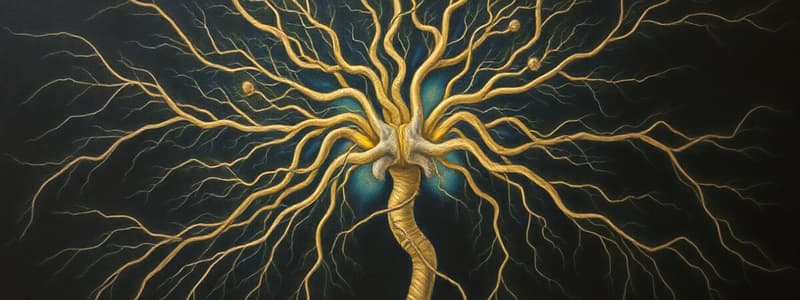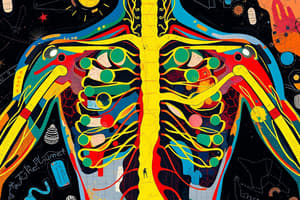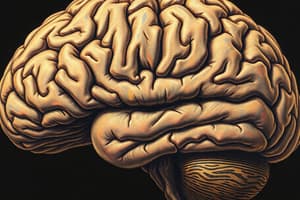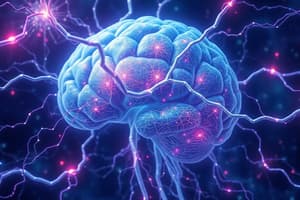Podcast
Questions and Answers
¿Cuál de las siguientes opciones es un ejemplo de reflejo defensivo?
¿Cuál de las siguientes opciones es un ejemplo de reflejo defensivo?
- Sonrisa
- Estornudo (correct)
- Dibujo
- Leer
Los reflejos pueden aparecer o desaparecer con:
Los reflejos pueden aparecer o desaparecer con:
- La música
- El clima
- La dieta
- La edad (correct)
Las neuronas son capaces de mitosis.
Las neuronas son capaces de mitosis.
False (B)
¿Qué neurotransmisor es específico en las sinapsis del sistema nervioso somático?
¿Qué neurotransmisor es específico en las sinapsis del sistema nervioso somático?
¿Cuál es la función principal del axón en una neurona?
¿Cuál es la función principal del axón en una neurona?
Las neuronas sensoriales cumplen la función de:
Las neuronas sensoriales cumplen la función de:
¿Qué tipo de neuronas tienen una sola prolongación que actúa como dendrita y axón?
¿Qué tipo de neuronas tienen una sola prolongación que actúa como dendrita y axón?
La función de las células de la neuroglia incluye:
La función de las células de la neuroglia incluye:
¿Cuál de las siguientes afirmaciones describe correctamente las neuronas multipolares?
¿Cuál de las siguientes afirmaciones describe correctamente las neuronas multipolares?
¿Cuál es la característica principal de las interneuronas?
¿Cuál es la característica principal de las interneuronas?
¿Cuál es la función de la sinapsis?
¿Cuál es la función de la sinapsis?
¿Qué tipo de neuronas son las más abundantes en el sistema nervioso?
¿Qué tipo de neuronas son las más abundantes en el sistema nervioso?
¿Qué estructura del sistema nervioso está principalmente asociada con la integración de reflejos simples?
¿Qué estructura del sistema nervioso está principalmente asociada con la integración de reflejos simples?
¿Cuál de las siguientes afirmaciones sobre el sistema nervioso vegetativo es correcta?
¿Cuál de las siguientes afirmaciones sobre el sistema nervioso vegetativo es correcta?
¿Cuál de los siguientes reflejos es un ejemplo de un reflejo directo?
¿Cuál de los siguientes reflejos es un ejemplo de un reflejo directo?
¿Qué tipo de reflejos son considerados como reflejos indirectos?
¿Qué tipo de reflejos son considerados como reflejos indirectos?
El sistema nervioso simpático está diseñado principalmente para:
El sistema nervioso simpático está diseñado principalmente para:
¿Cuál es una función de los reflejos de postura y locomoción?
¿Cuál es una función de los reflejos de postura y locomoción?
Los nervios raquídeos están compuestos por:
Los nervios raquídeos están compuestos por:
¿Qué nivel de organización del sistema nervioso es responsable de funciones complejas como el almacenamiento de información y el aprendizaje?
¿Qué nivel de organización del sistema nervioso es responsable de funciones complejas como el almacenamiento de información y el aprendizaje?
¿Cuál de las siguientes afirmaciones sobre los reflejos medulares es incorrecta?
¿Cuál de las siguientes afirmaciones sobre los reflejos medulares es incorrecta?
¿Qué tipo de reflejos se producen como respuesta a calambres o espasmos musculares?
¿Qué tipo de reflejos se producen como respuesta a calambres o espasmos musculares?
La regulación de la función cardiaca y respiratoria se integra en:
La regulación de la función cardiaca y respiratoria se integra en:
¿Cuál es la función principal de las neuronas intercalares en el arco reflejo?
¿Cuál es la función principal de las neuronas intercalares en el arco reflejo?
¿Qué tipo de arco reflejo se forma si intervienen solo dos neuronas?
¿Qué tipo de arco reflejo se forma si intervienen solo dos neuronas?
¿Cuál de las siguientes estructuras no sirve como centro nervioso para elaborar respuestas adecuadas?
¿Cuál de las siguientes estructuras no sirve como centro nervioso para elaborar respuestas adecuadas?
¿Qué reflejos se consideran como mecanismos de defensa básicos del organismo?
¿Qué reflejos se consideran como mecanismos de defensa básicos del organismo?
¿Cuál de las siguientes afirmaciones describe mejor la diferencia entre el sistema nervioso y el sistema endocrino?
¿Cuál de las siguientes afirmaciones describe mejor la diferencia entre el sistema nervioso y el sistema endocrino?
¿Qué respuesta involuntaria se caracteriza por la contracción de músculos flexores y relajación de músculos opuestos?
¿Qué respuesta involuntaria se caracteriza por la contracción de músculos flexores y relajación de músculos opuestos?
¿Cuál es la capa más externa de las meninges?
¿Cuál es la capa más externa de las meninges?
¿Qué función cumplen los reflejos en el organismo?
¿Qué función cumplen los reflejos en el organismo?
¿Qué característica esencial tienen las neuronas en relación a su reproducción?
¿Qué característica esencial tienen las neuronas en relación a su reproducción?
¿Qué ocurre en el arco reflejo cuando el estímulo es especialmente fuerte?
¿Qué ocurre en el arco reflejo cuando el estímulo es especialmente fuerte?
¿Cómo se transmite el impulso nervioso en las neuronas?
¿Cómo se transmite el impulso nervioso en las neuronas?
¿Qué concepto refleja la interacción del sistema nervioso con el entorno?
¿Qué concepto refleja la interacción del sistema nervioso con el entorno?
¿Qué función específica tiene el impulso nervioso relacionado con la defensa de un organismo?
¿Qué función específica tiene el impulso nervioso relacionado con la defensa de un organismo?
Flashcards
Reflex arc
Reflex arc
The neural pathway involved in a reflex action.
Reflex action
Reflex action
An involuntary response to a stimulus.
Reflexes
Reflexes
Involuntary actions crucial for survival.
Unconditioned Reflexes
Unconditioned Reflexes
Signup and view all the flashcards
Conditioned Reflexes
Conditioned Reflexes
Signup and view all the flashcards
Nervous System
Nervous System
Signup and view all the flashcards
Endocrine System
Endocrine System
Signup and view all the flashcards
Neuron
Neuron
Signup and view all the flashcards
Neurotransmitters
Neurotransmitters
Signup and view all the flashcards
Synapse
Synapse
Signup and view all the flashcards
Reflex
Reflex
Signup and view all the flashcards
Sensory Neuron
Sensory Neuron
Signup and view all the flashcards
Motor Neuron
Motor Neuron
Signup and view all the flashcards
Central Nervous System (CNS)
Central Nervous System (CNS)
Signup and view all the flashcards
Meninges
Meninges
Signup and view all the flashcards
Cerebrospinal Fluid (CSF)
Cerebrospinal Fluid (CSF)
Signup and view all the flashcards
Axon
Axon
Signup and view all the flashcards
Dendrites
Dendrites
Signup and view all the flashcards
Reflex Arc
Reflex Arc
Signup and view all the flashcards
Myelin Sheath
Myelin Sheath
Signup and view all the flashcards
Neuron Function
Neuron Function
Signup and view all the flashcards
Axon Structure
Axon Structure
Signup and view all the flashcards
Dendrite Function
Dendrite Function
Signup and view all the flashcards
Synapse Definition
Synapse Definition
Signup and view all the flashcards
Neuron Types (Mono, Bi, Multi)
Neuron Types (Mono, Bi, Multi)
Signup and view all the flashcards
Neuroglia Function
Neuroglia Function
Signup and view all the flashcards
Neuron Types (Functional)
Neuron Types (Functional)
Signup and view all the flashcards
Telodendria Function
Telodendria Function
Signup and view all the flashcards
Nervous System Function
Nervous System Function
Signup and view all the flashcards
Neuroendocrine Harmony
Neuroendocrine Harmony
Signup and view all the flashcards
Neuron Function
Neuron Function
Signup and view all the flashcards
Meninges Protection
Meninges Protection
Signup and view all the flashcards
Central Nervous System (CNS)
Central Nervous System (CNS)
Signup and view all the flashcards
Impulse Transmission Speed
Impulse Transmission Speed
Signup and view all the flashcards
Information Integration
Information Integration
Signup and view all the flashcards
Vertebrate Nervous System Structure
Vertebrate Nervous System Structure
Signup and view all the flashcards
Reflex Arc (simple)
Reflex Arc (simple)
Signup and view all the flashcards
Reflex Arc (complex)
Reflex Arc (complex)
Signup and view all the flashcards
Interneurons
Interneurons
Signup and view all the flashcards
Reflex
Reflex
Signup and view all the flashcards
Unconditioned Reflexes
Unconditioned Reflexes
Signup and view all the flashcards
Importance of Reflexes
Importance of Reflexes
Signup and view all the flashcards
Reflex Actions
Reflex Actions
Signup and view all the flashcards
Nervous System response
Nervous System response
Signup and view all the flashcards
Extrapyramidal Motor System
Extrapyramidal Motor System
Signup and view all the flashcards
Rubrospinal Tract
Rubrospinal Tract
Signup and view all the flashcards
Tectospinal Tract
Tectospinal Tract
Signup and view all the flashcards
Vestibulospinal Tract
Vestibulospinal Tract
Signup and view all the flashcards
Direct Reflex
Direct Reflex
Signup and view all the flashcards
Indirect Reflex
Indirect Reflex
Signup and view all the flashcards
Lower Brain Stem Structures (NEB)
Lower Brain Stem Structures (NEB)
Signup and view all the flashcards
Postural/Locomotion Reflex
Postural/Locomotion Reflex
Signup and view all the flashcards
Unconditioned Reflexes
Unconditioned Reflexes
Signup and view all the flashcards
Somatic Nervous System
Somatic Nervous System
Signup and view all the flashcards
Autonomic Nervous System
Autonomic Nervous System
Signup and view all the flashcards
Sympathetic Nervous System
Sympathetic Nervous System
Signup and view all the flashcards
Parasympathetic Nervous System
Parasympathetic Nervous System
Signup and view all the flashcards
Cranial Nerves
Cranial Nerves
Signup and view all the flashcards
Spinal Nerves
Spinal Nerves
Signup and view all the flashcards
Levels of Nervous System Organization
Levels of Nervous System Organization
Signup and view all the flashcards
Bulbar Region
Bulbar Region
Signup and view all the flashcards
Brainstem Function
Brainstem Function
Signup and view all the flashcards
Bulbo-Pontine Segment
Bulbo-Pontine Segment
Signup and view all the flashcards
Midbrain Division
Midbrain Division
Signup and view all the flashcards
Cranial Nerve Nuclei
Cranial Nerve Nuclei
Signup and view all the flashcards
Midbrain Function-Superior Colliculi
Midbrain Function-Superior Colliculi
Signup and view all the flashcards
Midbrain-Substantia Nigra
Midbrain-Substantia Nigra
Signup and view all the flashcards
Bulbar Nuclei
Bulbar Nuclei
Signup and view all the flashcards
Study Notes
Unidad IV: Sistema Nervioso - Introducción
- El sistema nervioso y el endocrino trabajan juntos para regular las funciones corporales, con el sistema reproductor que asegura la perpetuación de la especie.
- El sistema nervioso se diferencia del endocrino por su capacidad de respuestas rápidas. Los impulsos nerviosos se propagan en milisegundos, mientras que las respuestas hormonales tardan más pero duran más tiempo.
- El sistema nervioso recibe, integra e interpreta una gran cantidad de información del cuerpo para responder a las necesidades y estímulos del medio ambiente.
- Las funciones vitales del sistema nervioso incluyen la percepción de estímulos, la regulación de funciones corporales, la vida de relación, el aprendizaje, la respuesta adaptativa (innata y aprendida), y el almacenamiento de información.
- La neurona es la unidad funcional, con capacidad para establecer redes y transmitir impulsos nerviosos mediante neurotransmisores.
Organización Funcional del Sistema Nervioso - La Neurona
- La neurona es la unidad funcional del sistema nervioso, que conecta receptores y efectores a través de las fibras nerviosas.
- La neurona consta de soma, dendritas y axón, con botones terminales.
- Las neuronas son células altamente complejas, con la capacidad de generar, propagar, codificar e impulsar los impulsos nerviosos.
- La transmisión de impulsos nerviosos ocurre a través de la liberación de neurotransmisores.
Organización Funcional del Sistema Nervioso - La Sinapsis
- La sinapsis es el punto de unión entre neuronas o de una neurona a un efector, permitiendo la transmisión de impulsos nerviosos.
- El impulso nervioso se desplaza a través de neurotransmisores como acetilcolina y noradrenalina.
- Las sinapsis pueden ser excitadoras o inhibidoras, dependiendo de la acción del neurotransmisor liberado.
- Existen tres tipos de neuronas: monopolares, bipolares y multipolares.
- La velocidad de transmisión del impulso nervioso varía de 1 a 100 m/s.
- La transmisión sináptica implica un retraso de aproximadamente 5 milisegundos.
- La estimulación continuada o con alta frecuencia, causa fatiga sináptica.
- La vaina de mielina actúa como aislante para acelerar la transmisión de impulsos.
Neurotransmisores
- La adrenalina y la noradrenalina son neurotransmisores del sistema nervioso que regulan la acción de un grupo de aminas biógenas. También se incluyen la dopamina.
- La acetilcolina es un neurotransmisor clave en el sistema nervioso somático y vegetativo, involucrada en procesos como la regulación de procesos vegetativos y la funciones del SNC.
Receptores Nerviosos
- Los receptores son estructuras que convierten estímulos en impulsos nerviosos, que pueden ser extero e intero receptores.
- Los mecanorreceptores responden a estímulos como el tacto, presión, estiramiento o sonido.
- Los quimiorreceptores responden a estímulos químicos (gusto y olfato).
- Los fotorreceptores responden a estímulos luminosos (visión).
- Los propioceptores están en músculos y tendones, para el sentido de la posición y el movimiento en el espacio.
Acto y Arco Reflejo
- El reflejo es una respuesta involuntaria del cuerpo ante un estímulo, que se produce a través de un arco reflejo.
- La respuesta refleja puede ser simple (dos neuronas), o compleja (tres o más neuronas).
- El arco reflejo involucra un receptor, una neurona sensitiva, un centro nervioso, una neurona motora y un efector (músculo o glándula).
- Los reflejos incondicionados son respuestas innatas (reflejo de succión, la reacción de miedo), mientras que los reflejos condicionados son aprendidos (asociación entre un estímulo y una respuesta).
Niveles de Organización del Sistema Nervioso
- La médula espinal (NM) tiene, funciones de control motor y sensorial, también refleja.
- El nivel encefálico bajo (NEB) incluye el bulbo, protuberancia, mesencéfalo y cerebelo, con funciones de control autónomo y reflejo (respiración, deglución), control voluntario e involuntario, reflejo de la tos y estornudo.
- El nivel encefálico alto (NEA) es el cerebro, incluyendo las áreas motoras y sensitivas, con las más altas funciones del Sistema Nervioso, incluyendo aprendizaje, memoria y análisis.
Órganos de los Sentidos
- Órganos sensoriales como los ojos, oídos, nariz, lengua y piel, que permiten la percepción del medio ambiente.
Studying That Suits You
Use AI to generate personalized quizzes and flashcards to suit your learning preferences.
Related Documents
Description
Explora los conceptos fundamentales del sistema nervioso y su relación con el sistema endocrino. Aprende sobre la velocidad de las respuestas neurológicas y el papel crítico de las neuronas en la integración de estímulos. Este cuestionario te permitirá evaluar tu comprensión de cómo el sistema nervioso regula vitalmente las funciones corporales.




